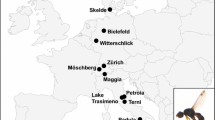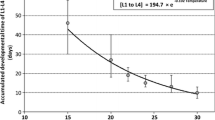Abstract
The relative roles of genetics and developmental plasticity in creating phenotypes adapted to prevailing conditions are insufficiently understood. In potentially multivoltine temperate insects, individuals that do not enter diapause but develop directly into reproductive adults within the same season are severely time-constrained. Direct development is, however, under selection only if expressed in the wild. Thus, adaptive correlates of the direct development are expected to evolve and persist only in multivoltine populations. We studied the genetic and phenotypic components of variation in juvenile development in the geometrid moth Chiasmia clathrata from univoltine and bivoltine regions. Larvae were reared at two temperatures (14/20 °C) and densities (low/high) in a factorial split-brood experiment. High temperature and low density promoted direct development, the former condition being associated with a short development time, high growth rate and large body size. Genotypes of bivoltine origin had a higher propensity for direct development and seemingly expressed an exaggerated plastic response to increasing temperature compared to the ones from univoltine populations. Alternative life history phenotypes associated with the induced developmental pathway emerged only in the bivoltine region, direct development resulting in a short larval period, high growth rate and small size at 20 °C there. The degree of differentiation between the developmental pathways was insensitive to larval density; high density only decreased both development time and body size to a certain degree. We conclude that the differences between the pathways are not due to the induction of a particular pathway itself, but geographically varying selection pressures shape the correlation structure among life history traits and their pathway-specific expression.





Similar content being viewed by others
References
Aalberg Haugen IM, Berger D, Gotthard K (2012) The evolution of alternative developmental pathways: footprints of selection on life-history traits in a butterfly. J Evol Biol 25:1377–1388
Agnew P, Hide M, Sidobre C, Michalakis Y (2002) A minimalist approach to the effects of density-dependent competition on insect lifehistory traits. Ecol Entomol 27:396–402
Angilletta MJ Jr (2009) Thermal adaptation, a theoretical and empirical synthesis. Oxford University Press, Oxford
Atkinson D, Sibly RM (1997) Why are organisms usually bigger in colder environments? Making sense of a life history puzzle. Trends Ecol Evol 12:235–239
Baayen RH (2011) languageR: data sets and functions with “analyzing linguistic data: a practical introduction to statistics”. R Package, version 1.4. Available at http://cran.r-project.org/
Baayen RH, Davidson DJ, Bates DM (2008) Mixed-effects modeling with crossed random effects for subjects and items. J Mem Lang 59:390–412
Bates D, Maechler M (2010) lme4: Linear mixed-effects models using S4 classes. R Package, version 0.999375-37. Available at: http://cran.r-project.org/
Blanckenhorn WU (1994) Fitness consequences of alternative life histories in water striders, Aquarius remigis (Heteroptera: Gerridae). Oecologia 97:354–365
Blanckenhorn WU, Demont M (2004) Bergmann and converse Bergmann latitudinal clines in arthropods: two ends of a continuum? Integr Comp Biol 44:413–424
Blanckenhorn WU, Fairbairn DJ (1995) Life history adaptation along a latitudinal cline in the water strider Aquarius remigis (Heteroptera: Gerridae). J Evol Biol 8:21–41
Danks HV (1987) Insect dormancy: an ecological perspective. Biological Survey of Canada, Ottawa
Davidowitz G, Nijhout HF (2004) The physiological basis of reaction norms: the interaction among growth rate, the duration of growth and body size. Integr Comp Biol 44:443–449
DeWitt TJ, Sih A, Wilson DS (1998) Costs and limits of phenotypic plasticity. Trends Ecol Evol 13:77–81
Diamond SE, Kingsolver JG (2010) Environmental dependence of thermal reaction norms: host plant quality can reverse the temperature-size rule. Am Nat 175:1–10
Fantinou AA, Tsitsipis JA (1999) Effect of larval density on development and diapause of Sesamia nonagrioides (Lef.) (Lep., Noctuidae) under laboratory conditions. J Appl Entomol 123:187–190
Friberg M, Dahlerus J, Wiklund C (2012) Strategic larval decision-making in a bivoltine butterfly. Oecologia 169:623–635
Gomi T (1997) Geographic variation in critical photoperiod for diapause induction and its temperature dependence in Hyphantria cunea Drury (Lepidoptera: Arctiidae). Oecologia 111:160–165
Gotthard K, Berger D (2010) The diapause decision as a cascade switch for adaptive developmental plasticity in body mass in a butterfly. J Evol Biol 23:1129–1137
Hadfield J (2012) MCMCglmm: MCMC generalised linear mixed models. R Package, version 2.17. Available at http://cran.r-project.org/
Hanski I (1988) Four kinds of extra long diapause in insects: a review of theory and observations. Ann Zool Fenn 25:37–53
Honěk A (1993) Intraspecific variation in body size and fecundity in insects: a general relationship. Oikos 66:483–492
Ishihara M (1999) Adaptive phenotypic plasticity and its difference between univoltine and multivoltine populations in a bruchid beetle, Kytorhinus sharpianus. Evolution 53:1979–1986
Karlsson B, Johansson A (2008) Seasonal polyphenism and developmental trade-offs between flight ability and egg laying in a pierid butterfly. Proc R Soc Lond B 275:2131–2136
Karlsson B, Stjernholm F, Wiklund C (2008) Test of a developmental trade-off in a polyphenic butterfly: direct development favours reproductive output. Funct Ecol 22:121–126
Kivelä SM, Välimäki P (2008) Competition between larvae in a butterfly, Pieris napi, and maintenance of different life history strategies. J Anim Ecol 77:529–539
Kivelä SM, Välimäki P, Carrasco D, Mäenpää MI, Oksanen J (2011) Latitudinal insect body size clines revisited: a critical evaluation of the saw-tooth model. J Anim Ecol 80:1184–1195
Kivelä SM, Välimäki P, Mäenpää MI (2012) Genetic and phenotypic variation in juvenile development in relation to temperature and developmental pathway in a geometrid moth. J Evol Biol 25:881–891
Larsdotter Mellström H, Friberg M, Borg-Karlsson A-K, Murtazina R, Palm M, Wiklund C (2010) Seasonal polyphenism in life history traits: time costs of direct development in a butterfly. Behav Ecol Sociobiol 64:1377–1383
Messina FJ (1991) Life-history variation in a seed beetle: adult egg-laying vs. larval competitive ability. Oecologia 85:447–455
Moran NA (1992) The evolutionary maintenance of alternative phenotypes. Am Nat 139:971–989
Mousseau TA, Roff DA (1989) Adaptation to seasonality in a cricket: patterns of phenotypic and genotypic variation in body size and diapause expression along a cline in season length. Evolution 43:1483–1496
Nijhout HF, Roff DA, Davidowitz G (2010) Conflicting processes in the evolution of body size and development time. Phil Trans R Soc Lond B 365:567–575
Nylin S (1992) Seasonal plasticity in life history traits: growth and development in Polygonia c-album (Lepidoptera: Nymphalidae). Biol J Linn Soc 47:301–323
Nylin S, Wickman P-O, Wiklund C (1989) Seasonal plasticity in growth and development of the speckled wood butterfly, Pararge aegeria (Satyrinae). Biol J Linn Soc 38:155–171
Pöykkö H, Hyvärinen M (2012) To grow fast or to grow big? Time-limited larvae of Eilema depressum speed up their growth and reduce the number of instars. Entomol Exp Appl 142:145–152
Pöykkö H, Tammaru T (2010) Countergradient vs. cogradient variation in growth and diapause in a lichen-feeding moth, Eilema depressum (Lepidoptera: Arctiidae). J Evol Biol 23:1278–1285
R Development Core Team (2012) R: a language and environment for statistical computing. Version 2.15.1. R Foundation for Statistical Computing, Vienna, Austria. Available at: http://www.r-project.org/
Roff DA (1980) Optimizing development time in a seasonal environment: the ‘ups and downs’ of clinal variation. Oecologia 45:202–208
Roff DA (2002) Life history evolution. Sinauer Associates, Sunderland
Sauer KP, Spieth H, Grüner C (1986) Adaptive significance of genetic variability of photoperiodism in Mecoptera and Lepidoptera. In: Taylor F, Karvan R (eds) The evolution of insect life cycles. Springer, Berlin, pp 153–172
Scoble MJ (1992) The Lepidoptera—form, function and diversity. Oxford University Press, NY
Sibly RM, Winokur L, Smith RH (1997) Interpopulation variation in phenotypic plasticity in the speckled wood butterfly, Pararge aegeria. Oikos 78:323–330
Simmons LW (1987) Competition between larvae of the field cricket, Gryllus bimaculatus (Orthoptera: Gryllidae) and its effects on some life-history components of fitness. J Anim Ecol 56:1015–1027
Sokal RR, Rohlf FJ (1995) Biometry. Freeman, New York
Spence JR (1989) The habitat templet and life history strategies of pond skaters (Heteroptera: Gerridae): reproductive potential, phenology, and wing dimorphism. Can J Zool 67:2432–2450
Stearns SC, Koella JC (1986) The evolution of phenotypic plasticity in life-history traits: predictions of reaction norms for age and size at maturity. Evolution 40:893–913
Tammaru T, Esperk T (2007) Growth allometry in immature insects: larvae do not grow exponentially. Funct Ecol 21:1099–1105
Tauber MJ, Tauber CA, Masaki S (1986) Seasonal adaptations of insects. Oxford University Press, NY
Teder T, Esperk T, Remmel T, Sang A, Tammaru T (2010) Counterintuitive size patterns in bivoltine moths: late-season larvae grow larger despite lower food quality. Oecologia 162:117–125
Välimäki P, Kivelä SM, Mäenpää MI, Tammaru T (2013) Latitudinal clines in alternative life histories in a geometrid moth. J Evol Biol 26:118–129
Van Dyken JD, Wade MJ (2010) The genetic signature of conditional expression. Genetics 184:557–570
Walters RJ, Hassall M (2006) The temperature size-rule in ectotherms: may a general explanation exist after all? Am Nat 167:510–523
Wiklund C, Friberg M (2011) Seasonal development and variation in abundance among four annual flight periods in a butterfly: a 20-year study of the speckled wood (Pararge aegeria). Biol J Linn Soc 102:635–649
Wiklund C, Nylin S, Forsberg J (1991) Sex-related variation in growth rate as a result of selection for large size and protandry in a bivoltine butterfly, Pieris napi. Oikos 60:241–250
Wilson K, Cotter SC (2008) Density-dependent prophylaxis in insects. In: Ananthekrishnan TN, Whitman DW (eds) Density dependent prophylaxis in insects. Science, Plymouth, pp 137–176
Winterhalter WE, Mousseau TA (2007) Patterns of phenotypic and genetic variation for the plasticity of diapause incidence. Evolution 61:1520–1531
Acknowledgments
We thank Matthew Symonds and three anonymous referees for useful comments on earlier drafts of the manuscript. This study was financed by Ella och Georg Ehrnrooths Stiftelse (grants to P.V. and S.M.K.), Finnish Cultural Foundation (P.V.) as well as Jenny and Antti Wihuri foundation (S.M.K.). All Finland’s guidelines and legal requirements for the use of animals in research were followed.
Author information
Authors and Affiliations
Corresponding author
Electronic supplementary material
Below is the link to the electronic supplementary material.
Rights and permissions
About this article
Cite this article
Välimäki, P., Kivelä, S.M. & Mäenpää, M.I. Temperature- and density-dependence of diapause induction and its life history correlates in the geometrid moth Chiasmia clathrata (Lepidoptera: Geometridae). Evol Ecol 27, 1217–1233 (2013). https://doi.org/10.1007/s10682-013-9657-8
Received:
Accepted:
Published:
Issue Date:
DOI: https://doi.org/10.1007/s10682-013-9657-8




